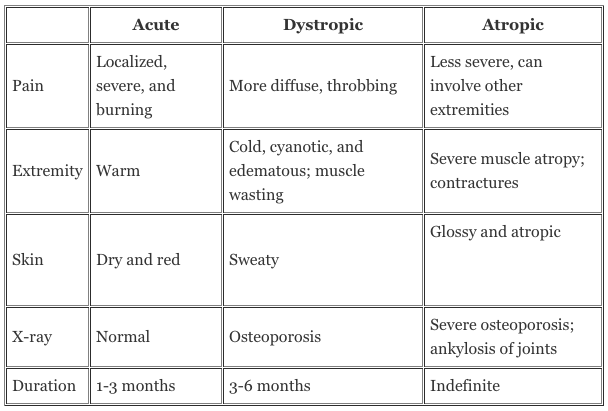Copy link
CRPS II: treatment
Last updated: 03/04/2015
Complex regional pain syndrome (CRPS), is a regional, posttraumatic, neuropathic pain problem that most often affects one or more limbs. Like most medical conditions, early diagnosis and treatment increase the likelihood of a successful outcome. Accordingly, patients with clinical signs and symptoms of CRPS after an injury should be referred immediately to a physician with expertise in evaluating and treating this condition. Physical therapy is the cornerstone and first-line treatment for CRPS. Mild cases respond to physical therapy and physical modalities. Mild to moderate cases may require adjuvant analgesics, such as anticonvulsants and/or antidepressants. An opioid should be added to the treatment regimen if these medications do not provide sufficient analgesia to allow the patient to participate in physical therapy. Patients with moderate to severe pain and/or sympathetic dysfunction require regional anesthetic blockade to participate in physical therapy. A small percentage of patients develop refractory, chronic pain and require long-term multidisciplinary treatment, including physical therapy, psychological support, and pain-relieving measures. Pain-relieving measures include medications, sympathetic/somatic blockade, spinal cord stimulation, and spinal analgesia.
Diagnosis
CRPS-1 is a syndrome where chronic pain (normally in an extremity) appears to be associated with sympathetic nervous system dysfunction after trauma. No single theory has explained sympathetic nervous system dysfunction in CRPS-1 and the pathophysiology is poorly understood. In general, the patient must meet the following criteria for diagnosis:
- There must be some initial noxious event (contusion, crush, or laceration, surgery, sprain, fracture, or dislocation). This initial event normally involves any kind of discrete nerve injury and may indeed be occult.
- There must be involvement distal to the site of injury.
- Pain, allodynia, and/or hyperalgesia must be present.
- Pain is always disproportionate to injury.
- Pain is never limited to a single nerve.
- The patient must have symptoms associated with sympathetic nervous system dysfunction (i.e. edema, changes in skin blood flow, sudomotor activity, etc…)
Patients complaining of pain in an area of decreased sensation, pain without cutaneous hyperalgesia or allodynia, pain only in a specific nerve distribution, or only proximal symptoms do NOT have CRPS-1. Finally, three phases of CRPS (acute, dystrophic, and atrophic) can often be identified: (see Table)
Treatment
For an excellent algorithm for the treatment of CRPS (I & II), see Rho et al. Mayo Clin Proc 77: 174, 2002
CRPS Treatment Algorithm (Adapted from Rho et al. Mayo Clin Proc 77: 174, 2002)
- Step 1: physical therapy
- Step 2: TCA, gabapentin, mild opioid if needed for physical therapy
- Step 3: diagnostic sympathetic block
- Step 4: somatic block of sympathetic block fails
- Step 5: spinal cord stimulator / intrathecal medications
CRPS is essentially a result of autonomic nervous system dysfunction. It can be categorized as CRPS Type 1 (formally Reflex sympathetic dystrophy) or CRPS Type 2 (formally Causalgia). It may or may not involve the sympathetic nervous system, hence the phrase sympathetically independent pain. Only one thing is certain about CRPS and that is the unpredictability of the condition. The cause is obscure and elusive, although we may identify sympathetic nervous system involvement in a subset of this population, hence the phrase sympathetically maintained pain.
Multimodal treatment is often necessary (and what I typically employ in my practice): Physical Therapy, anticonvulsants, antidepressants, occasional opioids, sympathetic nerve blocks, epidural infusions, bier blocks, intravenous infusions, radiofrequency ablation of sympathetic nervous system, and spinal cord stimulation. Also, CBT (Cognitive Behavioral Therapy) may be necessary.
The category of phases may be considered as an older way to view CRPS, however, currently CRPS may or may not have some or many of those features listed above.
Three stages may occur during the course of CRPS:
Stage 1 Either following an event or without apparent cause, the patient develops pain in a limb. The essential features include burning and sometimes throbbing pain, diffuse uncomfortable aching, sensitivity to touch or cold, and localized edema. The distribution of the pain is not compatible with a single peripheral nerve, trunk, or root lesion. Vasomotor disturbances occur with variable intensity, producing altered color and temperature. The radiograph is usually normal but may show patchy demineralization.
Stage 2 The second stage is marked by progression of the soft tissue edema, thickening of the skin and articular soft tissues, muscle wasting, and the development of brawny skin. This may last for three to six months.
Stage 3 The third stage is most severe. It is characterized by limitation of movement, the shoulder-hand syndrome (capsular retraction producing a frozen shoulder), contractures of the digits, waxy trophic skin changes, and brittle ridged nails. Bone radiography reveals severe demineralization.
Autonomic features including cyanosis, mottling, increased sweating, abnormal growth of hair, diffuse swelling in nonarticular tissue, and coldness may occur in the later stages. Urologic manifestations include detrusor hyperreflexia or areflexia, producing urgency, frequency, incontinence, or urinary retention.

References
- Rhichard H Rho, Randall P Brewer, Tim J Lamer, Peter R Wilson Complex regional pain syndrome. Mayo Clin. Proc.: 2002, 77(2);174-80 PubMed Link
Copyright Information

This work is licensed under a Creative Commons Attribution-NonCommercial-NoDerivatives 4.0 International License.